by Naomi | Feb 17, 2016 | Creative Life
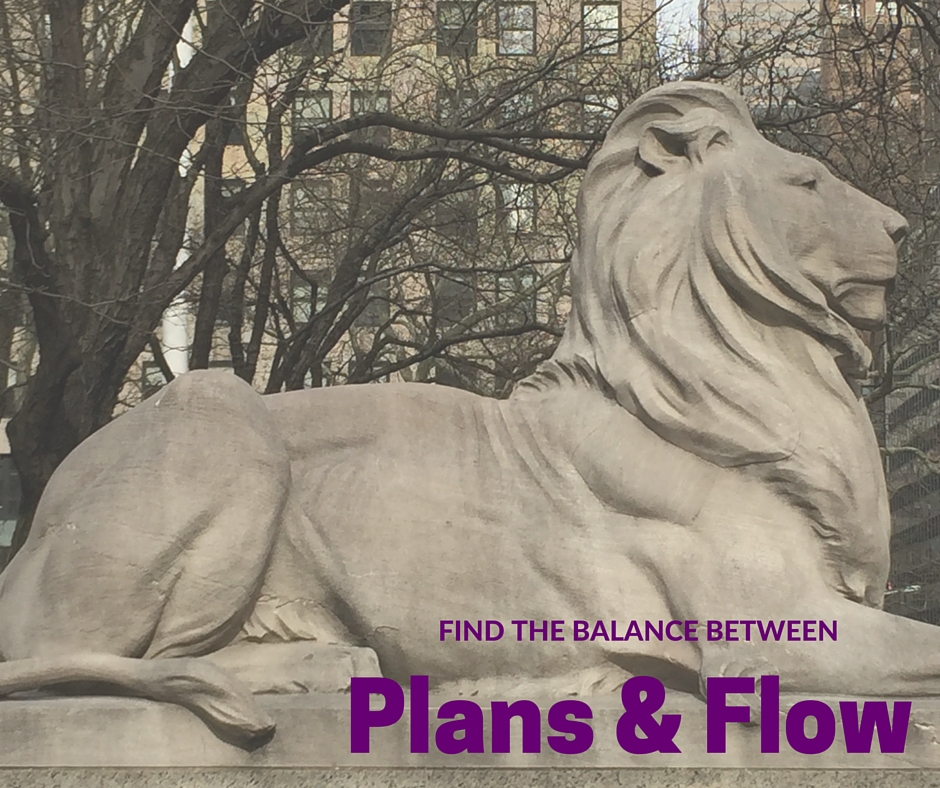 I’ve been flying through life at break-neck pace, and that’s how I ended up in New York with hardly an inkling of a plan. I knew I needed to be in town by Thursday mid-day for a meeting, and that the conference spanned the weekend. Other than that, I’d hardly consulted the schedule. I figured I’d find nooks and crannies in my schedule to explore New York, particularly since my husband was joining me for the weekend.
I’ve been flying through life at break-neck pace, and that’s how I ended up in New York with hardly an inkling of a plan. I knew I needed to be in town by Thursday mid-day for a meeting, and that the conference spanned the weekend. Other than that, I’d hardly consulted the schedule. I figured I’d find nooks and crannies in my schedule to explore New York, particularly since my husband was joining me for the weekend.
So, I flew in late Wednesday night and woke up Thursday morning with an empty slate. What to do?
My first thought was: I wish I’d made a plan. But my second thought was filled with curiosity: I wonder what’s around the corner from this hotel?
And the adventure began.
It turns out that around every corner in New York, surprises wait. Cathedrals, libraries, museums, unusual shops, coffee bars, restaurants, artists, musicians, a kaleidoscope of people–each a walking story in and of themselves. As I stepped onto the sidewalk in New York, I was swept into the bustling, vibrant flow.

If I’d had a plan, I’d have been frustrated. I can picture myself, head down against that cold New York wind, struggling toward my destination, missing all the surprises along the way. But without a plan, I could soak it all in, see what I didn’t know to look for, discover the richness that isn’t in the tour books.

I wonder how often my plans keep me from being in the flow?
Flow is quite different than drift. It’s true that without a plan, we have the potential to drift through life and find ourselves where we never would have chosen to be. But flow is a shortcut. Consider a character in a book who sets out to achieve a goal. By the end of the book, she nearly always finds that what she really needs is something deeper, more meaningful, than the goal she originally set. The plans she sets launch her into motion, but soon, the plan tends to get in the way. Why? Because she’s so focused on her idea of how things ought to go, she doesn’t allow margin for surprise. She doesn’t allow herself to be swept into the bigger story of what’s happening all around her. She’s struggling against the flow.

So how do we strike a balance between plans and flow?
- Start by not being afraid to set a goal. Take into account what’s true in your life, and using those givens, set a goal that points you in a specific direction.
- Head out boldly. Let your goal inform the questions that you ask and the experiences you seek out.
- Listen closely. Pay attention. Allow yourself to follow your curiosity. I wonder what’s inside that cathedral? Go ahead, wander a bit. Your goal will still be there waiting for you, but maybe you’ll see it in richer color through the stained glass windows.
- Look for secret passages and hidden doorways. Drift happens when we lose our way by following every distraction. Flow is being caught in an ever-increasing current and heading deeper in. Why did I set this goal? What’s underneath? What’s urging me onward?
- Keep in mind that “plan” is a noun and “flow” is a verb. When you’re in flow, there’s no destination. No one can stay in flow indefinitely. You’ll find beauty and joy along the way, and have a grand, meaningful adventure. And every now and again, you’ll get tangled in the weeds. When that happens, it’s time, again, to go back to the beginning and set a new plan.

Where are you right now? In a planning phase? Drifting? Flowing? Do you have particular questions you ask yourself that help you find flow? If so, I’d be so grateful if you’d share them. Share below, or feel free to connect with me on Twitter (@naomikinsman) or Facebook.
Here’s to you and your grand adventure!
—
Psst… Do you know about Naomi’s Writerly Play Kit: a weekly collection of curated resources, inspiration and encouragement? Keep your creative spark ablaze … sign up for exclusive access here.
by Naomi | Feb 2, 2016 | Creative Life
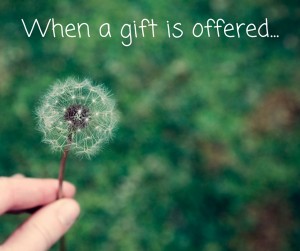
Have you ever given a gift, only to have it refused? There’s that horrible iron-door-slamming-shut-between-you feeling, the kind that makes you back away. Offering a gift is an invitation. You say to someone, “Will you accept this love I’d like to share?” When the person refuses, it’s not only the gift that’s shoved aside, but you.
And yet, accepting gifts isn’t always easy. Why?
Offering a gift is a vulnerable act. And accepting a gift may be even more vulnerable.
When you offer a gift, you’ve had time to think, prepare and plan. When you accept a gift, particularly a meaningful one, you often face the element of surprise. Unexpected emotions can leap up and catch you off guard. In most cases, to accept a gift you must acknowledge the fact that you can’t do everything on your own. All of these things … the emotions, the sharp pain of vulnerability, the questions, the fears … rise up like a tsunami wave as the gift is held out in open hands. The question is: Will you say yes?
I’ve been thinking a lot about gifts this week. I want to be the courageous kind of person who can accept gifts with open arms. Too often, I struggle.
We’re raising funds right now to support the work of Society of Young Inklings, and specifically for our new partnership with Boys and Girls Club of the Peninsula. As part of this campaign, we’re putting on a show and silent auction benefit on Friday. Our goal is to extend our reach and, as in all of our programs, to offer young writers support as they discover their unique voices. Through this fundraising process, I’ve been given a stream of extraordinary gifts.
- Our instructional staff has given the gift of their time. They’ve volunteered to collaborate on the script and spent hours rehearsing. Team members have offered leadership: directing the show, shaping and revising the script, costume and prop design, and much more.
- Our board has offered gifts of financial support and spread the word about our campaign and event near and far.
- Our development team has expertly helped me more clearly see the tangible impact of our work and also uncovered ways to continue to assess, refine and grow our programs.
- Our community has stepped up to provide donations for our silent auction and financial gifts in support of our work.
These gifts, overwhelming as they are, are only a small part of the flood of support we’ve experienced at Society of Young Inklings. And then, beyond SYI, daily gifts of support have been showing up in all corners of my life.
- In pour-over coffee hand-delivered to me at my desk by my husband while I’m struggling to meet a writing deadline.
- In friends spreading the word about the release of the Glimmer Girls books, a series of fiction on which I collaborated with singer, Natalie Grant.
- In friends reaching out to tell me they’re thinking about me.
- In the just-right book showing up at the just-right time.
And so much more.
Anyone who knows me very well knows that I’ve been working hard for quite some time now, reaching for a very big dream. And now, having so much support show up as I’m taking final steps toward a peak on the journey … it feels like a crowd of my friends and loved ones and colleagues have gathered on the sides of the path to cheer me on. To tell me they know I can make it to the end of this climb, even if I’m wondering about that, myself.
Honestly, these gifts take my breath away. Each time one is offered, I struggle to accept it.
But I’m practicing throwing my arms wide. I’m practicing saying … shouting … yes! I’m learning that gifts fill us with energy we didn’t think we had, an overflowing kind of energy that makes us ready to turn around and pass on gifts elsewhere. Gifts rejuvenate us and create momentum. Someone gives to us and that gift multiplies inside us. Now, we have the power to reciprocate and also to give with wider reach. On and on, the gifts ripple, growing in strength and possibility … because we said yes.
Many of you reading this post are part of that cheering crowd of supporters. To you, I want to say … I need to say … thank you. Your gifts mean more to me than I am able to put into words. Your gifts are making an impact far beyond what any of us can see today.
And so, what about you? What gift can you say yes to today? I’d love to hear your thoughts in the comment section below. Or, you can give me the gift of discussing this further with me on Twitter or on Facebook. I will gladly accept.
With much love and gratitude.
—
Psst… Do you know about Naomi’s Tinder Box: a weekly collection of curated resources, inspiration and encouragement? Keep your creative spark ablaze … sign up for exclusive access here.
by Naomi | Feb 1, 2016 | Tools & Apps
Naomi’s Playlist is an eclectic collection of tools that help me approach my work as play. My hope is that they’ll do the same for you!
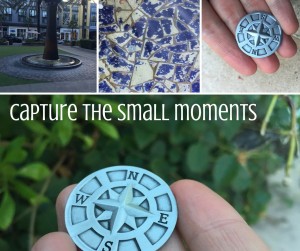
Object: Taking note of the small joyful moments in each day.
What Didn’t Work: Rushing through every day. Feeling like I should be paying attention or keeping track, somehow, but not quite succeeding. Making it to the end of the day and wondering where all the small moments had gone.
My Aha! Moment: On vacation in December, I was poking around with my Day One journaling app, which simplifies keeping a virtual journal. But truth be told, I like writing on paper more than I like typing on my phone. My thoughts seem to flow more freely from hand to paper. Yet, I’m conflicted about this because a digital tool can add images and is more likely to be with me all the time. Some days I have time to thoughtfully sit down with paper and pen, and other times, I just don’t.
So, my aha! moment came in two parts.
First, I gave myself permission to use more than one tool. A paper journal? Permission granted. Day One, because I was already using it? Also allowed. And exploring a new tool? Exploring was allowed, too.
Second, while exploring, I stumbled across HeyDay, a journaling app for the iPhone that takes your pictures and automatically turns them into collages. The app even pulls past photos from your stream and captures past memories. It’s like waving a magic wand and presto–A visual journal!
How I Play:
- Having HeyDay on my phone gives me a reason to stop and take photos at random times of the day. They doesn’t have to be a special photo-worthy moments. The point is remembering the small things. Who was I with today? Where did we go? What did we do? The more photos the better.
- HeyDay can use your GPS to keep track of where you go through your day. I like this feature because it helps me track beyond my pictures. Also, when I’m in an unusual location that I’ve been to before, the app prompts me to check out memories from that place in the past.
- Sometimes I caption my photos and other times I let the photos do all the work. Either way, I’ve paid the moment specific attention. No longer is life a blurry flow of moments I haven’t noticed. Little memories are captured in my phone and in my mental slideshow, too.
Player’s Notes:
- Using the GPS feature can burn up battery, so if you have battery difficulty with your phone, I’d turn this feature off. Or, be ready to charge your phone a little more often.
- I worried about security at first. I didn’t want to be sharing photos I hadn’t meant to share. From all I’ve read, everything is kept private … as private as something stored on an internet server can be. If you’re concerned about security, read up on the FAQ’s.
- You can delete images if you have pictures you take on your phone for other purposes (receipts, etc) that aren’t memory-worthy.
Take it to the Next Level:
- I realized after a few weeks that I only had pictures of everyone else. So, even if you’re camera shy, don’t be afraid to take selfies. That way, you’re present in the collages along with your family and friends.
- HeyDay allows you to add events in the past, so if you want, you can import old pictures and create older memories, too.
by Naomi | Jan 19, 2016 | Creative Life
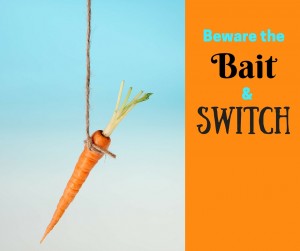
Yesterday, I finished a draft of a book. The project had a tight deadline and required my full concentration. Finishing was a big deal––a cause for true celebration. So, what happened the minute I reached my goal? My mind leapt to all the other things, you know, all those things I hadn’t been doing because I’d been concentrating on the book.
Fortunately, I caught myself in the middle of my “yes, but” thinking, and I remembered to stop, to celebrate what I HAD done, rather than focusing on all that I hadn’t finished. I don’t always catch myself, though.
In fact, I do this kind of bait and switch thing all the time. Here’s how it goes.
- I set a goal for my day.
- Sometimes, the goal is reasonable and I reach it.
- If I do reach my goal, total amnesia sets in about the agreement I made with myself.
- As I close my eyes to go to sleep, I scold myself for the laundry list of other things that are still undone.
Sound familiar?
The trouble is there are ALWAYS more things to do. Emails are always arriving in your inbox. Your laundry is being worn and becoming dirty. Your body is burning up the calories from your last meal and soon it will be time to shop for groceries and cook again. Don’t get me started on the dishes. Your dog is splashing around in mud puddles and tracking dirt into the house and your cat is shedding. Dust-bunnies are gathering. One assignment is done, and the next shows up.
It’s kind of funny––the way we demand the impossible of ourselves––but it’s also not funny at all. Because what’s really going on here is that we’re breaking trust with ourselves. We’re wearing down that strong inner muscle that allows us to achieve goals in the first place. Think about how it would work with a child. We ask the child to make their bed, and then when they proudly present their neatly-made bed, we point out their mid-process art project strewn across the desk. “Why didn’t you clean those up?” Because they were busy making the bed!
How motivated is that child going to be next time we ask them to make their bed?
We break trust with ourselves when we set one goal and score ourselves on another.
Too much broken trust, and I feel lackluster, ho-hum, meh. I can’t drum up the energy to reach for another goal. Of course I can’t. I’ve taught myself there will be no joy in the achieving of that goal. All there will be is more work. To me, that sounds like a recipe for a meaningless trudge through life.
So, today, I’m thinking about my trust-muscle, and how to develop it. How can I celebrate what has been done? How can I learn with my heart (not just my head) that when I’m doing one thing, that means I’m not doing any of the others? And how can I create systems that help me adjust and rebalance quickly after I’ve blocked out the world to reach for a really important goal?
One way I do this is to think about the six main areas of my life: core, commitment, creativity, connection, cultivation and casting dreams. I wrote about them a while back, and will probably write about them more soon. For now, maybe I’ll figure out a way to celebrate by investing time and attention in one or two of the areas that hasn’t been tended for a while. Maybe I can spend some time with a friend (connection) and make something just for the fun of it (creativity). Yep, that sounds like an excellent way to celebrate.
How about you? Have you baited and switched on yourself recently? What might you do to re-build some inner trust?
by Naomi | Jan 12, 2016 | Creative Life
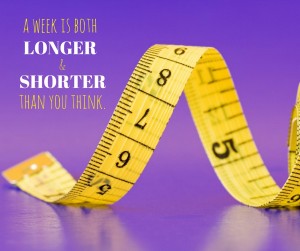 A week is both longer and shorter than you think.
A week is both longer and shorter than you think.
If you’re anything like me, you might set out on a Monday to do a laundry list of things, thinking that by Friday you’ll surely have time to complete them. Come Friday, you review the list and ugh! At least half of it remains.
As I was considering this sad state of affairs this past weekend, I noticed something interesting. While many boxes on my to-do list weren’t checked off, during the week I’d had a collection of small, interesting encounters. These encounters had started to shift things in my larger world. In fact, some challenged I’d have expected to work on for the rest of the year now had solutions right around the corner.
Which led me to ask myself: Is my to-do list full of the wrong things?
If PEOPLE can cause challenges to untangle, maybe I should spend more time making myself available. Maybe all that time spent on sorting, handling, drafting, researching, planning … maybe it could all be a little less important, if I only made myself more available.
Now, I’m sure that aimless availability wouldn’t have been helpful. But, since I’d spent a good amount of time in December thinking about my big-picture goals, this week, I was primed to pay attention to those things which might make the most big-picture difference.
Here’s a recipe for making progress that I plan to explore. I’ll let you know how it goes.
- Review my goals on Friday, note any progress over the week.
- Identify the chief obstacles. Right now, what’s immediately in the way? What do I need next?
- In relation to those needs and obstacles, think about the people around me. Consider the resources available through friends, co-workers, newcomers who have been suggested to me or who have just crossed my path. Or even online experts–bloggers, podcasters, and more.
- Decide: Who might I reach out to this week? Where might I go this week to encounter someone who just may have a new idea or solution for me?
When I go somewhere new or discuss a problem with a new person, I often find that creative doors and windows are thrown open. Solutions I didn’t expect alight on my shoulders with hardly any effort on my part. It almost feels like cheating. Except, it isn’t. I’m getting out of my own way, looking past my all important to-do list, and realizing that most of the time, the solution is closer than we think. All we have to do is ask.
So, that’s what I’m going to do. A whole lot more asking. Because I may not be able to check off all those to-dos in a week, but if I can ask the right question and toss most of those boxes off my list … well, I’d do that in a heartbeat!
How about you?
 I’ve been flying through life at break-neck pace, and that’s how I ended up in New York with hardly an inkling of a plan. I knew I needed to be in town by Thursday mid-day for a meeting, and that the conference spanned the weekend. Other than that, I’d hardly consulted the schedule. I figured I’d find nooks and crannies in my schedule to explore New York, particularly since my husband was joining me for the weekend.
I’ve been flying through life at break-neck pace, and that’s how I ended up in New York with hardly an inkling of a plan. I knew I needed to be in town by Thursday mid-day for a meeting, and that the conference spanned the weekend. Other than that, I’d hardly consulted the schedule. I figured I’d find nooks and crannies in my schedule to explore New York, particularly since my husband was joining me for the weekend. 



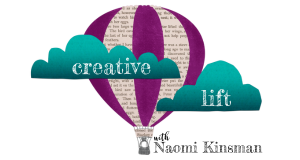



 A week is both longer and shorter than you think.
A week is both longer and shorter than you think.